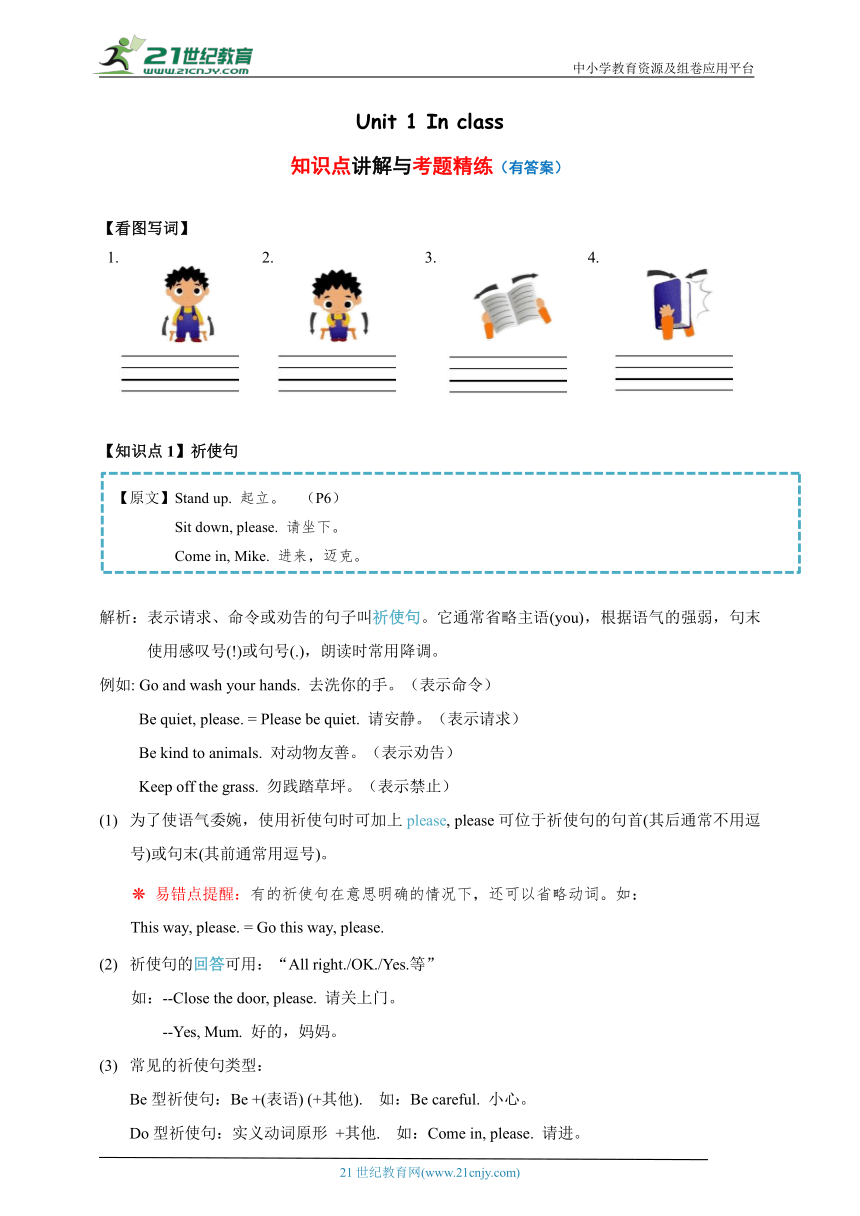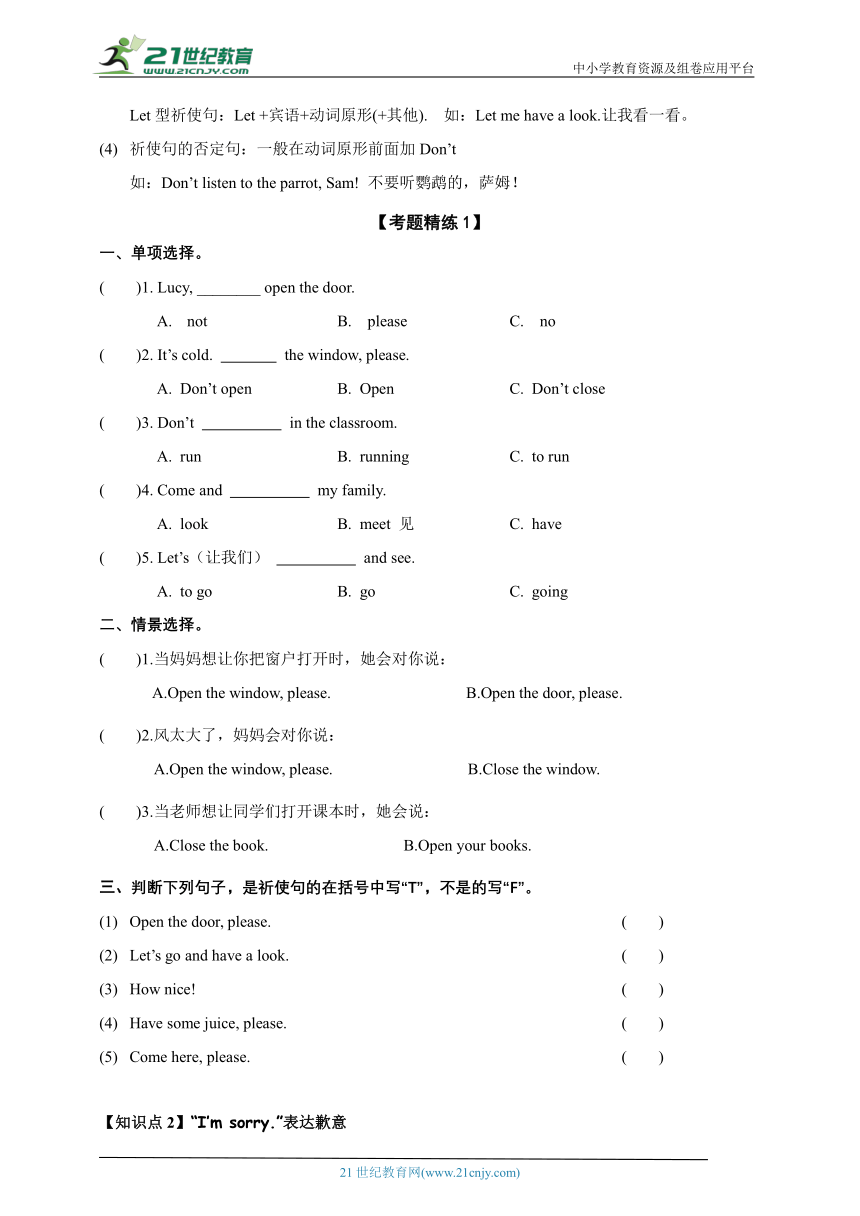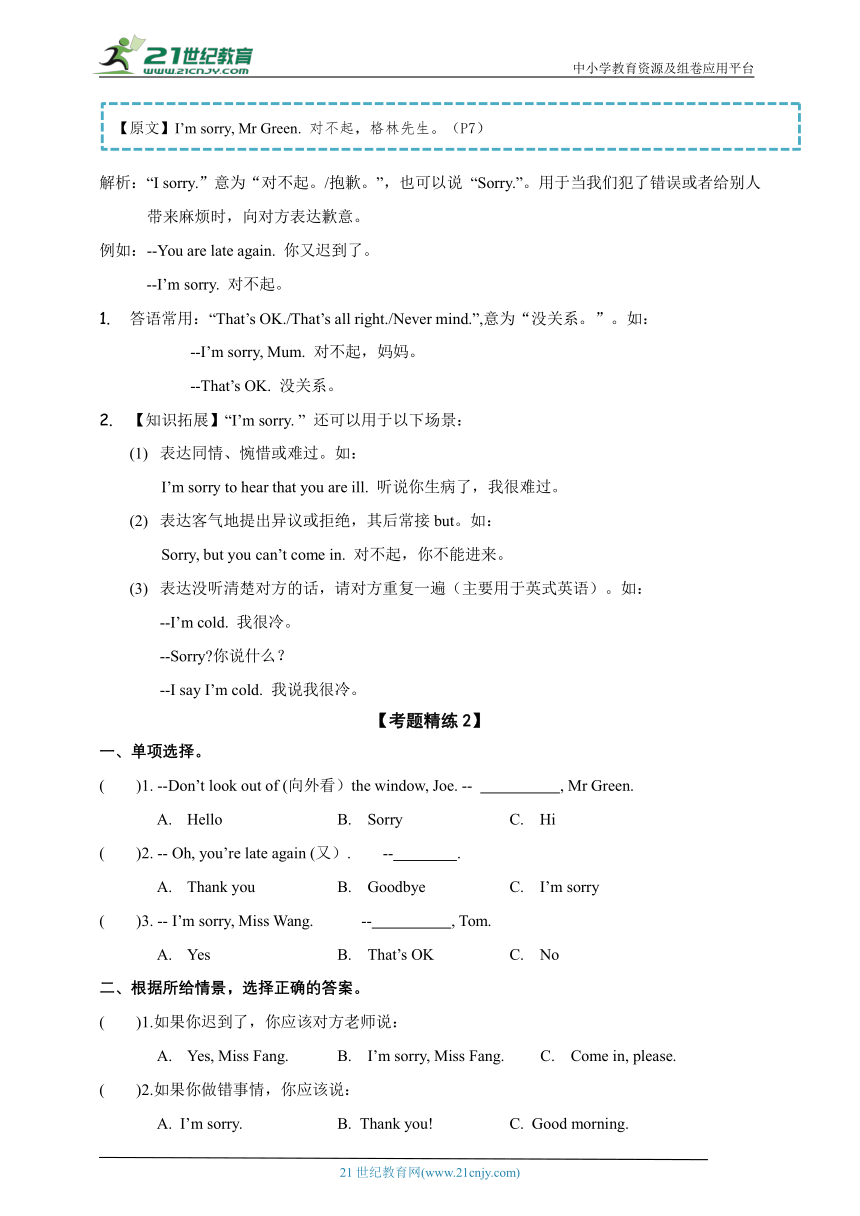Unit 1 In class知识点讲解与考题精练(含答案)
文档属性
| 名称 | Unit 1 In class知识点讲解与考题精练(含答案) |  | |
| 格式 | doc | ||
| 文件大小 | 1.8MB | ||
| 资源类型 | 试卷 | ||
| 版本资源 | 牛津译林版 | ||
| 科目 | 英语 | ||
| 更新时间 | 2023-01-29 16:07:41 | ||
图片预览



文档简介
中小学教育资源及组卷应用平台
Unit 1 In class
知识点讲解与考题精练(有答案)
【看图写词】
1. 2. 3. 4.
【知识点1】祈使句
解析:表示请求、命令或劝告的句子叫祈使句。它通常省略主语(you),根据语气的强弱,句末使用感叹号(!)或句号(.),朗读时常用降调。
例如: Go and wash your hands. 去洗你的手。(表示命令)
Be quiet, please. = Please be quiet. 请安静。(表示请求)
Be kind to animals. 对动物友善。(表示劝告)
Keep off the grass. 勿践踏草坪。(表示禁止)
为了使语气委婉,使用祈使句时可加上please, please可位于祈使句的句首(其后通常不用逗号)或句末(其前通常用逗号)。
易错点提醒:有的祈使句在意思明确的情况下,还可以省略动词。如:
This way, please. = Go this way, please.
祈使句的回答可用:“All right./OK./Yes.等”
如:--Close the door, please. 请关上门。
--Yes, Mum. 好的,妈妈。
常见的祈使句类型:
Be型祈使句:Be +(表语) (+其他). 如:Be careful. 小心。
Do型祈使句:实义动词原形 +其他. 如:Come in, please. 请进。
Let型祈使句:Let +宾语+动词原形(+其他). 如:Let me have a look.让我看一看。
祈使句的否定句:一般在动词原形前面加Don’t
如:Don’t listen to the parrot, Sam! 不要听鹦鹉的,萨姆!
【考题精练1】
单项选择。
( )1. Lucy, ________ open the door.
not please no
( )2. It’s cold. the window, please.
Don’t open Open Don’t close
( )3. Don’t in the classroom.
run running to run
( )4. Come and my family.
look meet 见 have
( )5. Let’s(让我们) and see.
to go go going
情景选择。
( )1.当妈妈想让你把窗户打开时,她会对你说:
A.Open the window, please. B.Open the door, please.
( )2.风太大了,妈妈会对你说:
A.Open the window, please. B.Close the window.
( )3.当老师想让同学们打开课本时,她会说:
A.Close the book. B.Open your books.
判断下列句子,是祈使句的在括号中写“T”,不是的写“F”。
Open the door, please. ( )
Let’s go and have a look. ( )
How nice! ( )
Have some juice, please. ( )
Come here, please. ( )
【知识点2】“I’m sorry.”表达歉意
解析:“I sorry.”意为“对不起。/抱歉。”,也可以说 “Sorry.”。用于当我们犯了错误或者给别人带来麻烦时,向对方表达歉意。
例如:--You are late again. 你又迟到了。
--I’m sorry. 对不起。
答语常用:“That’s OK./That’s all right./Never mind.”,意为“没关系。”。如:
--I’m sorry, Mum. 对不起,妈妈。
--That’s OK. 没关系。
【知识拓展】“I’m sorry. ” 还可以用于以下场景:
表达同情、惋惜或难过。如:
I’m sorry to hear that you are ill. 听说你生病了,我很难过。
表达客气地提出异议或拒绝,其后常接but。如:
Sorry, but you can’t come in. 对不起,你不能进来。
表达没听清楚对方的话,请对方重复一遍(主要用于英式英语)。如:
--I’m cold. 我很冷。
--Sorry 你说什么?
--I say I’m cold. 我说我很冷。
【考题精练2】
单项选择。
( )1. --Don’t look out of (向外看)the window, Joe. -- , Mr Green.
Hello Sorry Hi
( )2. -- Oh, you’re late again (又). -- .
Thank you Goodbye I’m sorry
( )3. -- I’m sorry, Miss Wang. -- , Tom.
Yes That’s OK No
根据所给情景,选择正确的答案。
( )1.如果你迟到了,你应该对方老师说:
Yes, Miss Fang. I’m sorry, Miss e in, please.
( )2.如果你做错事情,你应该说:
I’m sorry. Thank you! Good morning.
( )3.你把球踢到了对方的身上,应该说:
Good! Great! I’m sorry.
将下列句子重新排序,组成一段完整的对话。
That’s OK.
Yes, Dad.
Please close the door, Liu Tao.
Oh! My jacket.
E. I’m sorry, Dad.
C
【知识点3】询问物品的名称
“What’s this ”是由what开头的特殊疑问句,询问离自己较近的物品,句型结构为:
问句:What’s this
答语:It’s a/an +物品.
例如:--What’s this 这是什么? --It’s a doll. 它是一个玩具娃娃。
【拓展】询问离自己较远的物品,句型结构为:
问句:What’s that
答语:It’s a/an +物品.
例如:--What’s that 那是什么? --It’s a bird. 它是一只鸟。
【考题精练3】
单项选择。
( )1. --_________ this --It’s a toy car.
A. what’s B. What C. What’s
( )2. a robot.
It’s Its It
( )3. --What’s this --It’s _________ .
books B. a book C. an book
( )4. --_________ this -- is a cap.
A. What; this B. What’s; It C. What’s; it
情景选择。
( )1.你想问刘涛这是什么,可以问:
A.It’s a robot, Liu Tao. B.What’s this, Liu Tao
( )2.你想问这是什么,可以说:
A.What’s this B.This is a parrot.
参考答案
【看图写词】略
【考题精练1】
一、ABB
二、BAABB
三、TTFTT
【考题精练2】
一、BCB
二、BAC
三、CBDEA
【考题精练3】
一、CABB
二、BA
【原文】Stand up. 起立。 (P6)
Sit down, please. 请坐下。
Come in, Mike. 进来,迈克。
【原文】I’m sorry, Mr Green. 对不起,格林先生。(P7)
【原文】--What’s this --It’s a rubber.(P9)
--这是什么呢? --这是一快橡皮。
HYPERLINK "http://21世纪教育网(www.21cnjy.com)
" 21世纪教育网(www.21cnjy.com)
Unit 1 In class
知识点讲解与考题精练(有答案)
【看图写词】
1. 2. 3. 4.
【知识点1】祈使句
解析:表示请求、命令或劝告的句子叫祈使句。它通常省略主语(you),根据语气的强弱,句末使用感叹号(!)或句号(.),朗读时常用降调。
例如: Go and wash your hands. 去洗你的手。(表示命令)
Be quiet, please. = Please be quiet. 请安静。(表示请求)
Be kind to animals. 对动物友善。(表示劝告)
Keep off the grass. 勿践踏草坪。(表示禁止)
为了使语气委婉,使用祈使句时可加上please, please可位于祈使句的句首(其后通常不用逗号)或句末(其前通常用逗号)。
易错点提醒:有的祈使句在意思明确的情况下,还可以省略动词。如:
This way, please. = Go this way, please.
祈使句的回答可用:“All right./OK./Yes.等”
如:--Close the door, please. 请关上门。
--Yes, Mum. 好的,妈妈。
常见的祈使句类型:
Be型祈使句:Be +(表语) (+其他). 如:Be careful. 小心。
Do型祈使句:实义动词原形 +其他. 如:Come in, please. 请进。
Let型祈使句:Let +宾语+动词原形(+其他). 如:Let me have a look.让我看一看。
祈使句的否定句:一般在动词原形前面加Don’t
如:Don’t listen to the parrot, Sam! 不要听鹦鹉的,萨姆!
【考题精练1】
单项选择。
( )1. Lucy, ________ open the door.
not please no
( )2. It’s cold. the window, please.
Don’t open Open Don’t close
( )3. Don’t in the classroom.
run running to run
( )4. Come and my family.
look meet 见 have
( )5. Let’s(让我们) and see.
to go go going
情景选择。
( )1.当妈妈想让你把窗户打开时,她会对你说:
A.Open the window, please. B.Open the door, please.
( )2.风太大了,妈妈会对你说:
A.Open the window, please. B.Close the window.
( )3.当老师想让同学们打开课本时,她会说:
A.Close the book. B.Open your books.
判断下列句子,是祈使句的在括号中写“T”,不是的写“F”。
Open the door, please. ( )
Let’s go and have a look. ( )
How nice! ( )
Have some juice, please. ( )
Come here, please. ( )
【知识点2】“I’m sorry.”表达歉意
解析:“I sorry.”意为“对不起。/抱歉。”,也可以说 “Sorry.”。用于当我们犯了错误或者给别人带来麻烦时,向对方表达歉意。
例如:--You are late again. 你又迟到了。
--I’m sorry. 对不起。
答语常用:“That’s OK./That’s all right./Never mind.”,意为“没关系。”。如:
--I’m sorry, Mum. 对不起,妈妈。
--That’s OK. 没关系。
【知识拓展】“I’m sorry. ” 还可以用于以下场景:
表达同情、惋惜或难过。如:
I’m sorry to hear that you are ill. 听说你生病了,我很难过。
表达客气地提出异议或拒绝,其后常接but。如:
Sorry, but you can’t come in. 对不起,你不能进来。
表达没听清楚对方的话,请对方重复一遍(主要用于英式英语)。如:
--I’m cold. 我很冷。
--Sorry 你说什么?
--I say I’m cold. 我说我很冷。
【考题精练2】
单项选择。
( )1. --Don’t look out of (向外看)the window, Joe. -- , Mr Green.
Hello Sorry Hi
( )2. -- Oh, you’re late again (又). -- .
Thank you Goodbye I’m sorry
( )3. -- I’m sorry, Miss Wang. -- , Tom.
Yes That’s OK No
根据所给情景,选择正确的答案。
( )1.如果你迟到了,你应该对方老师说:
Yes, Miss Fang. I’m sorry, Miss e in, please.
( )2.如果你做错事情,你应该说:
I’m sorry. Thank you! Good morning.
( )3.你把球踢到了对方的身上,应该说:
Good! Great! I’m sorry.
将下列句子重新排序,组成一段完整的对话。
That’s OK.
Yes, Dad.
Please close the door, Liu Tao.
Oh! My jacket.
E. I’m sorry, Dad.
C
【知识点3】询问物品的名称
“What’s this ”是由what开头的特殊疑问句,询问离自己较近的物品,句型结构为:
问句:What’s this
答语:It’s a/an +物品.
例如:--What’s this 这是什么? --It’s a doll. 它是一个玩具娃娃。
【拓展】询问离自己较远的物品,句型结构为:
问句:What’s that
答语:It’s a/an +物品.
例如:--What’s that 那是什么? --It’s a bird. 它是一只鸟。
【考题精练3】
单项选择。
( )1. --_________ this --It’s a toy car.
A. what’s B. What C. What’s
( )2. a robot.
It’s Its It
( )3. --What’s this --It’s _________ .
books B. a book C. an book
( )4. --_________ this -- is a cap.
A. What; this B. What’s; It C. What’s; it
情景选择。
( )1.你想问刘涛这是什么,可以问:
A.It’s a robot, Liu Tao. B.What’s this, Liu Tao
( )2.你想问这是什么,可以说:
A.What’s this B.This is a parrot.
参考答案
【看图写词】略
【考题精练1】
一、ABB
二、BAABB
三、TTFTT
【考题精练2】
一、BCB
二、BAC
三、CBDEA
【考题精练3】
一、CABB
二、BA
【原文】Stand up. 起立。 (P6)
Sit down, please. 请坐下。
Come in, Mike. 进来,迈克。
【原文】I’m sorry, Mr Green. 对不起,格林先生。(P7)
【原文】--What’s this --It’s a rubber.(P9)
--这是什么呢? --这是一快橡皮。
HYPERLINK "http://21世纪教育网(www.21cnjy.com)
" 21世纪教育网(www.21cnjy.com)
